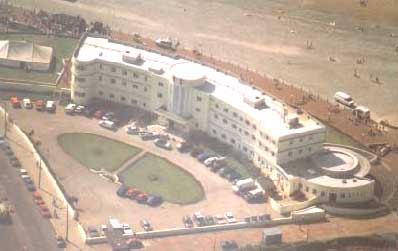
CRISIS AT MIDLAND HOTEL
IHBC
September 2002
Issue
4

CRISIS AT MIDLAND HOTEL
Oliver Hill's Art Deco masterpiece is under threat following
the recent collapse of proposals to restore the hotel.
In May, the
future for the building, and with it the image of Morecambe, looked bright. A
£10m refurbishment scheme had just
started on site, a huge marketing exercise was underway, and a grand re-opening
was planned for the spring of 2003. After years of relentless decline, the
building had reached a turning point, and was to become a five star hotel,
carefully restored, and promoted as the ultimate 1930s experience.
Today, it is
again abandoned, windows smashed, security fencing removed, the heating system
disabled, and vulnerable to the harsh storms of
This is the latest twist in the sad story of
a building that inspires a particular affection and admiration nationwide.
Opened in 1933, the Midland was built by the LMS Railway Company as an
optimistic statement of modernism, and it put Morecambe on the map. But
following wartime requisition, it suffered under a succession of unsuccessful
owners, culminating in the farcical ‘guardianship’ of Les Whittingham, who
arranged for the great Eric Gill stone relief of Odysseus Welcomed to the Sea
by Nausica to ‘disappear’ on its return from an exhibition at the Barbican. It
was finally rediscovered by police in Lincolnshire after a tip off around the
time that Whittingham died in 1998.
Now rescue plans are under discussion once
again. The HLF has allocated £1 million to the Midland under the Morecambe THI.
Lancaster City Council, English Heritage, the NWDA, and the Friends of the
Midland are working together to
find a long-
term solution. And there is the immediate
task of protecting the building against another winter.
Peter de Figueiredo, historic buildings
inspector, English Heritage
The views expressed by contributors (including
the editor) do not necessarily represent those of the

Civil and council
officers, from Nepal and Feltre in Italy, involved in the Asia -Urbs
(Europe-Asia) Urban management and Economic Diversification Project, attended a
World Heritage Seminar in Chester in June. The weeks events included a conference
addressed by Donald Insall, Peter de Figueiredo (English Heritage) and Miss
Minja Yang Deputy Director of World Heritage Centre, Paris. Delegates visited
many historic sites in the North West and Wales, including existing and
proposed World Heritage Sites.
Archaeology
by Condition
The
Royal George, Knutsford
A
recent case of the Royal George, in Knutsford, has again highlighted the issue
of pre-determination archaeological evaluations, as recommended in Planning
Policy Guidance Note 16: Archaeology and
Planning. Adrian Tindall, Principal Archaeological Officer at Cheshire
County Council explains the significance of the case to other areas.
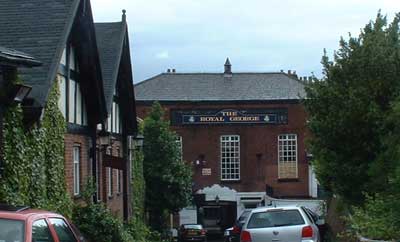
Archaeology had been a material
consideration in planning since the 1980s, however, in 1990, the new PPG16 went
further in emphasising:
·
the
need for archaeological policies in local plans,
·
the
desirability of preserving archaeological remains in situ,
·
the
importance of early consultation, and
·
the
need to assess their archaeological impact before planning applications are
determined.
In the twelve years since its
publication, PPG16 has led to some 400 archaeological projects being carried
out in Cheshire.
In
July 2001, an application for planning permission and listed building consent
was submitted to Macclesfield Borough Council for conversion, alteration,
partial demolition and extensions to the Grade II listed Royal George, on King
Street, Knutsford. The former hotel
occupies part of the east-facing frontage of King Street, the main route
through the medieval borough.
Archaeological Potential
Both the Royal George and
its adjacent plot seemed likely to occupy the site of earlier medieval
buildings, since the long narrow plots to the rear display the typical plan of
medieval burgage plots. The site also
lay within Knutsford’s Area of Archaeological Potential, as defined in the
Macclesfield Local Plan and confirmed by the recently-completed Cheshire
Historic Towns Survey.
In view of this, and in
accordance with PPG16, the Borough Council was advised that the developer be
required to commission an initial, desk-based archaeological assessment before
the application was determined. This
would identify any potential archaeological constraints to development and the
need for any further archaeological work.
Model
Condition
Unfortunately, this assessment
was not carried out before the application went to the borough’s planning
committee in November 2001. Ideally, in
such circumstances, determination would have been refused or deferred in
accordance with PPG16 Paragraph 22.
However in the absence of this, the local planning authority was advised
to attach the model condition provided by PPG16 Paragraph 30:
“No development shall take place until the applicant, or his agent or successors in title, has secured the implementation of a programme of archaeological work in accordance with a written scheme of investigation which has been submitted by the applicant and approved by the planning authority”.
This could be used to secure the
previously-advised desk-based assessment, as well as any further archaeological
work (field evaluation and mitigation) that the study may show to be necessary.
Assessment Conclusions
In the event, determination of the
application was deferred, allowing time for the assessment to be carried
out. The assessment concluded, perhaps
unsurprisingly, that areas of potential archaeological importance survived
across the less disturbed parts of the site, and recommended field evaluation
of 5% of these areas. Again the advice
was that this work be carried out prior to determination of the planning
application. This is also entirely in
accordance with PPG16 Paragraphs 21:
“Where
early discussion with local planning authorities, or the developers’ own
research, indicate that important archaeological remains may exist, it is reasonable
for the planning authority to request the prospective developer to arrange for
an archaeological field evaluation to be carried out before any decision on the
planning application is taken.”
and 22:
“Local
planning authorities can expect developers to provide the results of
(archaeological) assessments and evaluations as part of their application for
sites where there is good reason to believe there are remains of archaeological
importance…. and if necessary authorities will need to consider refusing
permission for proposals which are inadequately documented.”
Again, it was recommended that, should
planning permission be granted, the archaeological work be secured through the
use of the model condition.
Pragmatic
The
reasons for using the model condition are purely pragmatic. Experience has shown that local planning
authorities in Cheshire are often reluctant to require applicants to carry out
pre-determination evaluation, and clearly feel more comfortable securing
archaeological work through planning condition.
Indeed, there have been cases where an insistence on pre-determination
evaluation has led the LPA to overlook archaeology altogether, or formulate its
own condition, rather than delay determination.
This has, in turn, led to inadequate archaeological investigation (or
none at all), with the resultant loss of important archaeological
evidence. It is to prevent this,
while expressing a clear preference for pre-determination
evaluation, that LPAs are offered the fallback position of securing exploratory
archaeological work through planning condition.
Risks
There
are of course strong arguments against this approach.
1) where evaluation does not take place until
after the planning application has been determined, the possibility of archaeological
issues being fully taken into account in reaching the planning decision is
lost. In other words, the site’s
archaeology – however important - cannot influence the outcome of an
application.
2) securing archaeological work
through planning condition can, because it takes no account of the site’s
archaeological potential, incur the developer in unexpected and unquantified
archaeological costs.
3) there is often pressure on
LPAs to discharge such conditions prematurely – thus placing at risk the
post-excavation stages of the archaeological work.
Early Investigation
In
practice, of course, each application must be judged on its merits, and it must
be accepted that in some cases the arguments for pre-determination evaluation
are stronger than in others. However,
both national planning guidance and local plan policy make it clear that, where
there is a strong case for evaluation, there is an onus on local planning
authorities to insist on such work being carried out before the application is
determined. Only then can archaeological
issues be set alongside other material considerations in reaching a planning
decision.
Ironically,
the evaluation at the Royal George, when eventually carried out, demonstrated
that early archaeological deposits on the site had been almost entirely removed
by later development – a question that might have been resolved had the work
been commissioned some eight months earlier!
The case also raised the rather uncertain
relationship between below- and above-ground archaeology in Cheshire. The County Council’s advice to the boroughs
is restricted to below-ground archaeology, and it is assumed that the listed
building issues will be addressed by the boroughs’ own conservation
officers. However the distinction
between above- and below-ground archaeology is becoming increasingly blurred,
and is somewhat at odds with government advice, which regards the historic
environment in an increasingly holistic way.
The government has set out its agenda for
the future of the historic environment, both in the policy document The Historic Environment: A Force for Our
Future and in the broader context of the Green Paper Planning: Delivering a Fundamental Change. These include proposals to develop County
Sites and Monuments Records into comprehensive Historic Environment Records
(HERs), and a commitment to review older PPGs such as PPG15 and PPG16 - the
obvious implication being that they will be combined into a single PPG covering
the whole of the historic environment.
AT
Editors
Notes
Pre application evaluations are likely to be
required in areas of archaeological potential. These areas have been identified
for those towns where historic towns surveys have been completed (see NorthWest 3 p6).
The conclusions of the historic towns’ surveys should be relayed to DC
officers.
The Royal George evaluation was complete in
4 days and the written report in 3 weeks. If necessary, North West
has been reliably informed this could have been condensed into 10 days. PH
Liverpool City Council and English Heritage,
as well as organisations such as Liverpool Vision and the North West
Development Agency, have joined forces to seek the nomination of Liverpool’s
historic waterfront, commercial centre and cultural quarter as a World Heritage
Site. The bid is separate but complimentary, from the City’s bid for Capital of
Culture 2008,. The City Council and EH are also jointly funding a World Heritage
Officer for four years to co-ordinate the nomination. World Heritage Officer
John Hinchcliffe explains why.
 There are now 721 WHSs in
124 countries. They are either natural WHSs (such as The Grand Canyon)
or cultural WHS’s, which include items such as, monuments, groups of buildings
or sites, recognised by UNESCO as being of
outstanding universal value to the international community. Cultural WHS’s
are chosen from iconic structures such as The Great Wall of China, the Taj
Mahal and The Pyramids. In the UK there are 18 Cultural WHS, including
Stonehenge, The Tower of London and the City of Edinburgh.
There are now 721 WHSs in
124 countries. They are either natural WHSs (such as The Grand Canyon)
or cultural WHS’s, which include items such as, monuments, groups of buildings
or sites, recognised by UNESCO as being of
outstanding universal value to the international community. Cultural WHS’s
are chosen from iconic structures such as The Great Wall of China, the Taj
Mahal and The Pyramids. In the UK there are 18 Cultural WHS, including
Stonehenge, The Tower of London and the City of Edinburgh.
Cultural heritage is not restricted to
ancient civilisations and ancient buildings. The three latest cultural WHSs in
the United Kingdom (declared in December 2001), were Saltaire in Bradford, The
Derwent Valley Mills in Derbyshire and New Lanark in Scotland all pioneers, in
their own way, of the Industrial Revolution. The awards acknowledge that from
the late 18th Century until the early 20th Century, the
United Kingdom was the foremost industrial nation in the world and has an
industrial heritage, of unique international significance.
The Department of Culture,
Media and Sport have placed Liverpool on a tentative list of World Heritage
Sites, describing it as the "supreme" example of a commercial port,
which developed at the time of Britain’s greatest global influence. The
proposed World Heritage Site is therefore based on the historic port, but is
also likely to include the William Brown Street cultural quarter, an expression
of civic pride, funded by profits from the port.
·
The
world’s first commercial enclosed wet dock was constructed in Liverpool in
1715,
·
By
the end of the 19th Century, there were 120 hectares of wet docks,
10 kilometres of fortress-like dock walls and a vast range of warehouses,
·
Britain
was the foremost industrial nation in the world and Liverpool conducted 1/3 of
its export trade and ¼ of its import trade. Liverpool owned 1/3 of the total
shipping of the United Kingdom and 1/7 of the total registered shipping in the
world. Liverpool was amongst the 4 greatest ports in the world
·
The
docks were served by a commercial district of banks, exchanges, mercantile
offices and insurance companies, unrivalled outside London. These were designed
to impress and reached their peak with the showpiece ensemble at the Pier Head,
intended to be one of the world’s greatest river frontages.
·
Of
the 5.5 million emigrants who crossed the Atlantic 1860-1900, 4.75 million
sailed from Liverpool
· The great prosperity of 19th Century Liverpool was matched by a desire and ability to display civic pride, demonstrated by the construction of prestigious public buildings, notably St. George’s Hall. The monumental group of classical buildings around William Brown Street is one of the finest Victorian street scenes in the country.

Benefits
Liverpool
would benefit from World Heritage designation in a number of ways
·
Liverpool’s
historic importance and its surviving architectural interest would be
acknowledged globally
·
Liverpool
would be a greater attraction for international tourism
·
Liverpool
would have an increased heritage status when bidding for national and
international funding
·
An
effective management plan for the World Heritage Site would guide Liverpool’s
continuing regeneration through conservation and help to achieve high quality
design.
In order to secure the nomination of the WHS
by the DCMS and its subsequent designation (known as inscription), it is
necessary to prepare an assessment to convince UNESCO that the site is of
outstanding universal value. A
management plan is then required to demonstrate that the site will be properly
cared for in the future. The management plan must recognise that Liverpool is a
dynamic city undergoing a renaissance, and must not necessarily seek to prevent
change. Rather, it should seek to ensure that the best of the site’s heritage
assets are properly preserved and enhanced and that any new development is of
an appropriate quality.
UNESCO advise that the participation of
local people in the nomination process is essential to make them feel
responsible for the maintenance of the site. A major publicity and consultation
exercise has already started and initiatives are being undertaken to engage the
community. The target date for submission of the nomination is 1st
February 2003 and inscription (designation) should then follow in 2004.
Liverpool has led the World in many fields,
not least in football and music, but of course there is so much more to
Liverpool. The City Council, in partnership with English Heritage, aims to put
Liverpool firmly on the map as an important place in world history and as an
exemplar of regeneration through conservation.
John Hinchliffe
World
Heritage Officer 0151 233 5367
John.Hinchliffe@Liverpool.gov.uk
RIBA
AWARDS
Of the five North West schemes,
honoured in this years RIBA Awards, three were for works to listed buildings. Shed KM received two awards
for their conversions of The Collegiate and the Bryant and May Matchworks (both
Liverpool), while a new, small practice, Hakes Associates (London) received a
deserved award for their barn conversion, which now houses at Wycoller Visitor
Centre, near Colne. In all three
schemes, the interventions were of a contemporary design.
The RIBA's North West region is
larger than the IHBC's and also includes Cumbria. It is therefore difficult to
understand why the excellent refurbishment of Ballie Scot's Blackwell failed to
receive an award, despite it being nominated. The outstanding arts and crafts
house has recently opened to the public, following its refurbishment by Allies
and Morrison (London), and provides a fascinating and inspirational visit for
anyone with an interest in late Victorian architecture and interior design.
The Collegiate, Shaw Street, Liverpool
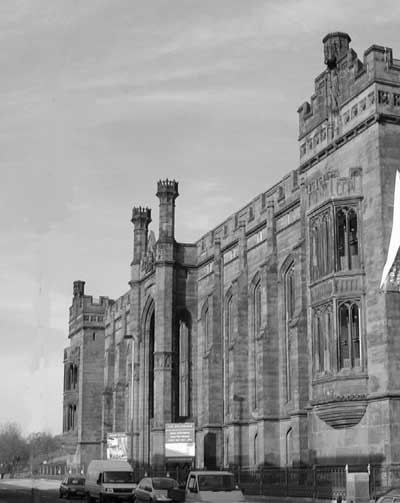
The Collegiate was designed by Harvey
Lonsdale Elms, architect of Liverpool's St Georges Hall, and is listed Grade
II*.
The school closed, in the mid 1980s after
140 years, following a fire in the octagonal theatre to the rear. A number of refurbishment schemes were
suggested considered but none were considered viable. The building continued to deteriorate and in
the early 1990s a second major fire destroyed the interior of the main
building. By the mid 1990s its future was uncertain.

The work was completed in Autumn 2001 and the building was formally opened with 50% of the 96 apartments sold.
The Collegiate is acting as a catalyst for
the regeneration of the area. Liverpool
Hope University College is about to commence work on Phase IV of their Everton
Campus and Riverside Housing Association has invested in the refurbishment of
the Georgian terrace opposite. A local
developer is about to restore the adjacent former Particular Baptist Chapel.
GM
The Matchworks, Speke Road, Liverpool

The conversion and restoration of the former
Bryant and May match factory by Speke/Garston Development Company (SGDC) and
Urban Splash presents a stunning frontage to Speke Road.
The building was designed by architects'
Mews & Davies in the early 1920's, the design adapted from the American
automotive industry, utilising pioneering "flat slab" construction.
The design of the sleek and elegant interior is credited to the engineer Sven
Bylander. Elements of the building are now listed Grade II.
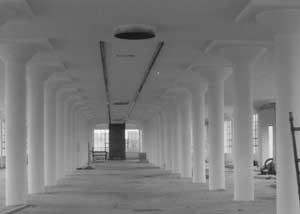
The scheme was developed in two phases,
Phase I, completed 18 month ago, provided 40,000sq ft of light industrial space
for various local businesses to the rear of the site. Phase II, which addressed
the listed frontage building, was recently completed and has provided 66,000sq
ft of refurbished office space.
The ground floor was converted into 6
separate "pavilions" each with their own front door and a new
mezzanine floor. On the upper floor,
approximately 40,000sq ft, was identified as a large floor plate for a large
single (B1) office user. To the rear,
six contemporary "service pods" have been constructed. Works were
completed in August 2001 and within a few months of completion all the space
has been let to B1 office space users.
This project is a key example of the
public/private partnership that has been responsible for regenerating the
area. The SGDC and the Speke Garston
Partnership have successfully transformed the economy of this once depressed
part of Liverpool and soon there will be more people working in the complex
than when it was a match factory.
Glynn Marsden
Principal Conservation Officer
Liverpool City Council, Regeneration -
Planning & Building Control
0151 233 5678
Photographs courtesy of Speke/Garston
Development Company
Wycoller
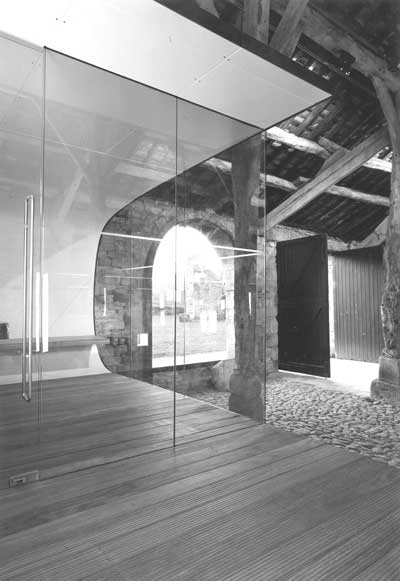
Hakes Associates were recipients of an RIBA
Award for their bold but sympathetic alterations to the Grade II listed barn at
Wycoller. Located in the shadow of the Pennines, the barn is a medieval timber
framed aisled structure built upon on stone walls The refurbished barn provides exhibition and museum
facilities, with display space being provided along a free-standing metal wall,
containing glass sections lit from within. The wall hides a long ramp that
provides access to a modern curved pod: a heated kiosk, for an attendant. A
stage has also been provided and the scheme considerably improves access for
disabled persons.
The new insertions are all prefabricated,
free standing and placed on stilts. The stilts are to avoid flooding (as the
barn is located in a narrow valley) but also has the benefit of retaining the
cobble and flagstone floor. The scheme complies with English Heritage's
guidelines on the conversion of historic farm buildings by maintaining the
spacious open interior of the barn, and utilising only existing and previous
openings.
PH
NorthWest spoke to Rosemary Lyons of Pendle
Borough Council.
Photographs: Hakes Associates
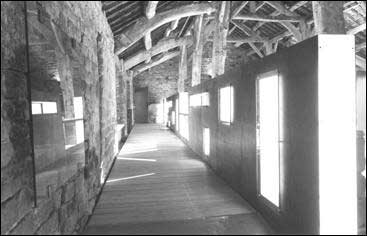
RIBA Housing Design Awards
Shed KM were also one of only six
winners of RIBA Housing Design Awards given as part of Architecture Week 2002,
for their conversion of Preston Point, adjacent to the Birkenhead Tunnel
entrance, in Liverpool. The annual awards are run jointly by with the Office of
the Deputy Prime Minister, The National House-Building Council, and the Royal
Town Planning Institute. They reward new housing developments that reflect the
highest standards of architectural design, and make a lasting difference to the
quality of the communities they serve. Preston Point was originally two
warehouses and forms part of a triangular block which is being progressively
regenerated by Urban Splash and Maritime Housing Association for a mixture of
commercial and residential uses.
PH
A
Sporting Chance
The occasion of the Commonwealth Games has
triggered a pilot study looking at the contribution Manchester has made to the
nations sporting history.
Manchester was chosen because of its huge
wealth of sporting facilities however only a small part of this heritage enjoys
any statutory protection.
The study began in January 2002 and
culminated in a major conference in June.
The aim of the study is to encourage wider
debate on the future of England's sporting heritage.
Opinion polls carried out by EH indicate
that a large majority of people attach great significance to both past events
and former sport venues.
However sporting clubs and local authorities
are under constant pressure from users and regulatory bodies to upgrade
facilities.
To avoid the inadvertent loss EH are looking
to develop a framework for understanding the relative importance of sporting
structures.
EH then intend to explain to the relevant
sporting bodies how that information can be best used, balancing the needs of a
particular sport against the wider historical importance of the ground or
facility.
Among several ideas being considered is the
preservation of a stranding terrace at an English football or rugby club.
North West spoke to Malcomb Cooper of
English Heritage. He advised that there are few immediate implications for
local planning authorities. However, guidelines are due to be published by
English Heritage and Sport England before the end of the current financial
year. The guidelines are unlikely to recommend wholesale listing or scheduling,
but are likely to encourage greater recognition being given to the influence of
sporting heritage on the character of communities. Therefore the presence of
sporting facilities may become increasingly important when preparing
conservation area appraisals.
Additional initiatives may include the
creation of a sports heritage trust to look after certain ground and facilities
and the possible extension of versions of the blue plaque scheme to illustrate
the heritage of local sporting heroes.
PH